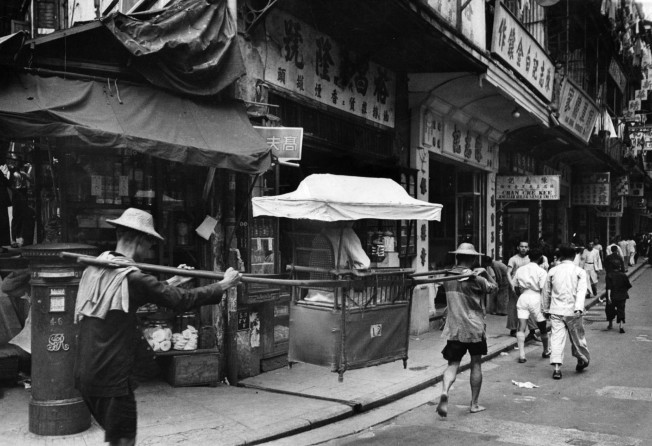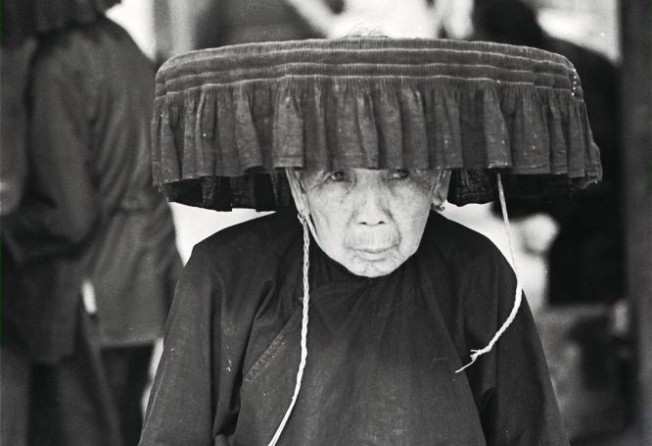
Baseball caps became standard wear in post-war Hong Kong, but it wasn’t the Americans’ doing
- Hats in Hong Kong were historically chosen for practical reasons, but fashion took over when the baseball cap was adopted to mimic the post-war Japanese
- Sedan chair bearers wore a woven bamboo hat of a particular pattern to indicate the dialect they spoke; Hakka women’s fringed hats proved a hit with Nepalis

Hats – for both sexes – have enjoyed a variegated history in Hong Kong. Straw hats have always been popular; light and comfortable, they kept their wearer in the shade and didn’t heat the head unduly.
One form of heat-protective headgear that never really took off here was the pith helmet, or sola topee. Unlike in parts of India or Africa, the heat in Hong Kong was just not extreme enough.
Mainly used as parade dress for certain British Army regiments, and the Hong Kong Police, these were sometimes labelled “coal scuttle” helmets for their scoop-like shape.
Ceremonial use of the helmet survived until the very end of British rule – governor Chris Patten’s aide-de-camp wore one at their official departure from Government House in Hong Kong’s Central district in 1997.

Forms of cultural hybridity came into play in the interwar years, when many Chinese men continued to don the male cheongsam as everyday wear, paired with narrow-brimmed felt fedora hats. As a fedora helped keep the head (and thus, the rest of the body) warm, they were more commonplace winter wear in Hong Kong. In north China, where cool conditions prevailed for longer, they were worn year-round.
By the 1960s, in tandem with the widespread decline of the male cheongsam, felt hats also gradually disappeared.
Baseball caps became fashionable among young men in the post-war era, with the exponential growth in American popular culture and in particular, the game’s popularity in Japan. Sartorial mimicry came into play; though in this instance, it was less a case of Hong Kong Chinese trying to look like Americans, as Hong Kong Chinese imitating Japanese dressed as Americans.
Whatever the transcultural origins, these caps remain the most commonly worn headgear in contemporary Hong Kong, for both sexes.
Chinese woven bamboo hats helped indicate the wearer’s language or dialect group. Old photographs or newsreel footage of sedan chair depots in urban areas show chair bearers lined up awaiting passengers, often in different patterns of hat. Individual choice played a role, but, as ever, practical considerations were paramount.

Until standard language modelling through mass education and exposure to radio, films and television gradually eliminated differences, Cantonese had significant regional variation, and could be almost incomprehensible between those from different areas.
Sedan chair bearers were generally migrant workers from elsewhere in the Pearl River Delta, who had come to Hong Kong in search of economic opportunities. A passenger who spoke the particular variant indicated by a certain form of hat might well seek that bearer out, as much to make sure he understood directions as for any lingering “home-district” fellowship.
Ethnic marker headgear has crossed ethnic boundaries; flat, woven bamboo, crownless Hakka farmer’s hats, with a black cloth fringe around the brim, were once worn exclusively by agricultural workers in the New Territories.

Practical, hard-wearing and cheap, they have been widely adopted these days by female Nepali outdoor workers in urban areas, mainly street sweepers, who first spotted them two generations earlier, when British Army Gurkha regiments were stationed near Kam Tin and Fanling.
In mid-1930s Japan (and Thailand), ultra-right wing governments mandated “civilised” dress codes; hats for women when wearing “Western” dress were among them. In China, the Nationalist government’s New Life Movement attempted the same, but with limited success. Ultimately, the idea was to keep insidious – and possibly corrosive – aspects of foreign popular culture under control; dance bands were also a target of suppression.
Like many similar campaigns against “foreign influence”, ultimately these drives were responses of insecure, increasingly paranoid governments whose leaders thought that as far as Westernisation was concerned, they could have modernity’s omelette and keep their own cultural eggs intact; no political power has yet managed to achieve that feat indefinitely, whatever strongman was in charge.